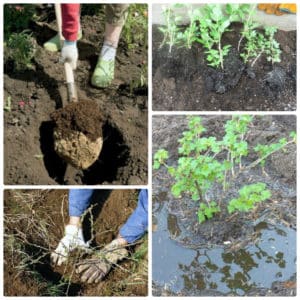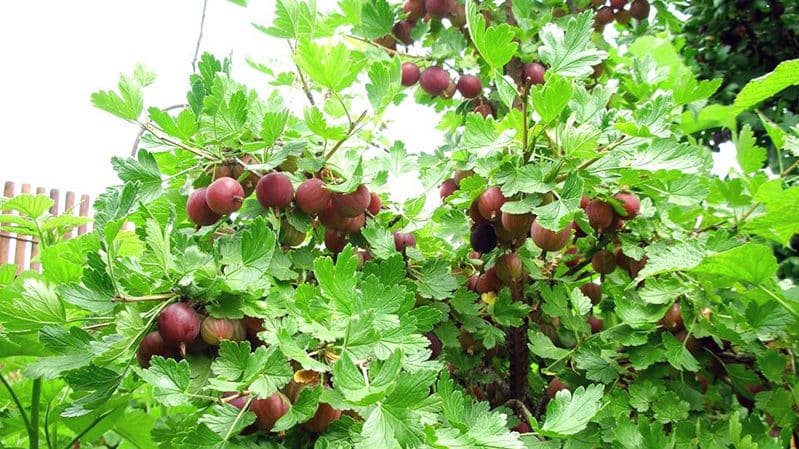Favorable conditions for growing berries: what kind of soil does gooseberries like and how to properly enrich it
Gooseberries are the highest-yielding crop among berry bushes. When planted correctly, the bush produces up to 12 kg of juicy berries and bears fruit for 20 or more years in a row. The plant is unpretentious in care and cultivation. It only needs a warm, sunny area for planting, moderate humidity and nutritious soil.
In this article we will tell you what kind of soil gooseberries like - acidic or alkaline - and when they can be planted.
The importance of choosing the right soil for gooseberries

Proper soil ensures high yield and early ripening of gooseberries. The most important requirement for planting is a sunny, open place. Then you can safely expect large, sweet berries.
High air permeability and moderate moisture are important requirements for soil. If you do not follow them, the bushes will be weak and may be affected by powdery mildew.
Planting in lowlands and places with high groundwater levels is unacceptable. They must lie at a depth of at least 1.5 m from the soil surface.
To prevent bushes from suffering from lack of moisture, they are not planted next to trees, maintaining a distance of at least 2 m. Tree species significantly dry out the soil in their root zone.
Gooseberries are not planted at higher elevations - the soil in such places is more susceptible to drying out. In addition, the bushes will be exposed to frost, since weak snow cover will not provide them with sufficient protection.
Important! Prickly gooseberry bushes make weeding very difficult, so all weeds must be removed before planting.
What kind of soil does gooseberry like?

Gooseberries are not as demanding on the soil as their berry counterparts. He likes:
- open, bright places;
- non-wetland;
- moderate humidity;
- warming ground.
For planting bushes, preference is given to well-drained, fertile areas.
Reference. If the site has clay soil, add a bucket of sand to it when planting gooseberries.
Optimal composition
Loose, fertile, nutritious soil, rich in humus, is ideal for gooseberries. Both clayey and loamy, as well as sandy loam and sandy soil are suitable for planting.
Reference. The optimal acidity for gooseberries is considered to be pH in the range of 5.5-6.5.
Humidity
Gooseberries do not like waterlogging. If there is excess moisture, the roots of the bushes rot. The plant, on the contrary, can withstand drought. To plant gooseberries, you need soil that is moist to the touch, but crumbles when squeezed in your fist.
How to improve soil for gooseberries

All soil indicators for planting gooseberries can be corrected:
- acidity;
- alkalinity;
- fertility.
For this purpose, organic and mineral fertilizers are used.
How to enrich it
If the soil is poor and infertile, it requires a mixture of organic fertilizers:
- urea - 20-30 g;
- superphosphate - 50 g;
- potassium chloride - 15-20 g.
For greater effect, fertilizers are applied directly into the planting hole. If the soil is sandy, lay a layer of clay up to 7 cm thick on the bottom; if it is clayey, add the same amount of sand.
How to change acidity and alkalinity
An acidity level below 5 pH will not allow the plant to absorb many useful elements, in particular calcium and magnesium. In such cases, the area is limed. The optimal time for this is early spring. Lime flour is added to a depth of about 20 cm at the rate of 200 g per 1 square meter. m and water generously. This procedure is repeated no more than once every 5 years.
Fertilizing is one of the fastest ways to adjust pH levels.
For this use:
- potassium sulfate;
- ammonium sulfate;
- potassium chloride;
- superphosphates;
- sodium or calcium nitrate.
They help a bush that grows in acidic soil to obtain anions instead of cations. Positive cations remain in the soil and contribute to its alkalization.
Preparing gooseberries before planting
Before planting, pruning shears are used to trim broken, damaged and dried roots down to living tissue.
Not every seedling is suitable for planting. The length of the plant does not play a special role, but the age does matter. The younger the seedlings, the easier and faster they will take root.
The root system is carefully examined - it should not be dry and lifeless. The health of a seedling can also be checked by the condition of the bark by tearing off a small piece from a branch or trunk.
If the surface under the bark has a greenish tint, the seedling is healthy; if it is brown, it is no longer alive. If the seedling has leaves, carefully remove them before planting, as they evaporate moisture. This can dry out the seedling if you plan to store it for some time before planting.
Attention! When removing leaves, be careful not to damage the buds in the axils.
During transportation, the root part of the seedlings is wrapped in a damp rag and placed in a bag.If planting a seedling on a site is postponed for some time, it must be dug in: dig a small trench and place the seedling in it with a slope to the south. This will help develop the plant's root system.
The bush is sprinkled so that the roots and half of the shoots are underground, and watered abundantly. After these steps, the seedlings will last several weeks until they are fully planted.
When preparing planting holes, take into account the size of the root system.
Fertilizers are added to the bottom of the pit:
- 1-2 kg of manure;
- 90 g superphosphate;
- 100 g wood ash.
The components are thoroughly mixed, poured into the hole and watered. The gooseberry roots are straightened and carefully placed in the hole. Then they fill it with nutritious soil, compact the soil and water the plants - a bucket of water for each bush. To retain moisture, the ground is mulched.
Suitable for this:
- non-acidic peat;
- humus;
- dry land.
The mulch layer should be about 5 cm. Plant the root collar of the seedling no deeper than 5-6 cm. Cut off the shoots immediately after planting or the next day. It is necessary that growths remain on the soil surface and on each of them there are 3-4 healthy buds. The sections are treated with garden varnish.
Soil care when growing gooseberries

Loosening the soil under the bushes is a prerequisite for the development of the plant. This is especially true during the period of autumn rains and spring meltwater. Compacted soil quickly loses moisture and makes it difficult for air to reach the roots.
Increased attention is paid to weeding. Weeds take away nutrients, provoke the development of diseases and reproduction pests.
During periods of no rain, gooseberries must be watered and the area around the bush must be mulched.
Attention! Water the gooseberry bushes only at the roots.If water gets on the leaves, the plant may become sick.
During the flowering and fruiting period, gooseberries need small portions of organic fertilizers.
Use by choice:
- manure;
- peat;
- compost.
Any of these root fertilizers are added dropwise under the plants at the rate of 5 kg per bush.
At the beginning of autumn, the bushes are weeded and organic debris collected over the summer is removed. Fallen leaves are burned, as pathogens of various diseases live on them.
In the summer, after each watering, the soil is loosened by 10-12 cm between the rows and by 3-4 cm in the tree trunk zone. During the season, the soil between the rows must be loosened at least 5 times.
To protect the plant from diseases and pests, make a soil cushion within the radius of the crown of the bush.
In the fall, the plant is treated. If the gooseberries are covered with a white coating, this is powdery mildew, one of the most dangerous diseases. Treatment depends on the growth period of the bush.
During flowering and fruiting, 3 sprayings are carried out once a week or once every 10 days.
Solution:
- 5 g soda ash;
- 50 g grated laundry soap;
- 10 liters of water.
Berries with a white coating or brown crust, diseased shoots and yellowed leaves are destroyed.
If a white coating is detected before the buds open, the bushes and the soil under them are sprayed with fungicides:
- Nitrofen solution;
- 3% solution of iron sulfate;
- 1% solution of copper sulfate.
The second procedure is carried out 10-12 days after the gooseberries bloom.
In the fall, before the first frost approaches, gooseberries are pruned. This will help get rid of old, damaged branches and form a fruit-bearing bush. After pruning, no more than 6 healthy shoots are left on the bush. They should be located at approximately the same distance from each other.
When the first snow falls, it is thrown under the gooseberry bushes. It will protect them from the upcoming cold weather.
This is interesting:
General characteristics and description of hairy gooseberry varieties
High-yielding frost-resistant gooseberry variety Masheka
The best gooseberry varieties for the Urals and Siberia: description and reviews
Other conditions for successful cultivation of gooseberries

Gooseberries are a light-loving plant, so they need to be planted in an open, sunny area. Lack of lighting leads to lower yields, crushing and a more sour taste of berries.
In the warmth and under the rays of the sun, the plant will quickly become covered with greenery, bloom and begin to bear fruit. When planting in autumn or spring, the optimal temperature for strengthening the roots is considered to be between +10°C during the day and +5°C at night.
The place for future berry bushes should be located on a plain or a small hill. It is important that the site is protected from cold north-east winds.
When to plant gooseberries
The optimal time for planting gooseberries is autumn. There should be at least 2 weeks left before the first frost, so it is preferable to plan planting for the end of September - beginning of October. In autumn, the root system takes root better, the seedling has time to get stronger and develop before frost for the arrival of spring. Spring planting is also practiced; The scheme for its implementation is the same as for the autumn period.
Important! If you decide to plant berry bushes in the fall, mulch the soil with peat or dry leaves.
Conclusion
Growing gooseberries will not cause problems; they are easy to care for. The main thing is to choose an open place for planting, water the plant in a timely manner, loosen and fertilize the soil.Fragrant berries of green, red, yellow, purple colors are good both fresh and processed. They are widely used as a filling for baking and making jams, preserves, compotes and even wine.